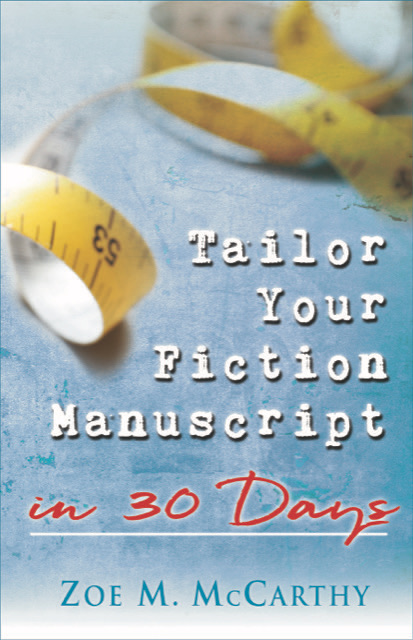

Tailor Your Fiction Manuscript in 30 Days is now available. See details below.
Writers may think characters should talk and act like real people. If a movie showed actors doing that, the theater would soon be empty. That’s why films cut to the important dialogue and actions. It’s the same with novels.
Purposeful dialogue, inner thoughts, and actions deepen motivation, conflict, and tension.
Let’s take a look at an example.

No Purpose (reality)
“You’re back,” Alex said, looking over his newspaper. “Where’ve you been?”
“To the store.” Gretta set her grocery bag on the floor.
“Did you get milk? I’m low on milk for my morning cereal.”
“Yes.” Gretta crossed to the African violet on the window sill and plucked away brown leaves. The plant looked better.
“Good.” Alex turned his attention to his newspaper.
Gretta moved across the room and collected a stack of folded laundry on the coffee table. “Well, I guess I should put the groceries away and get dinner started.”
Analysis: The example shows no conflict or tension to intrigue readers. Nothing is said, thought, or done that tells us something about the characters. Boring.

Purpose: Show a Shaky Marriage
“You’re back,” Alex tossed his book onto the end table. “Where’ve you been?”
Gretta set her grocery bag on the floor and planted her hands on her hips. “Where do you think I’ve been?”
Alex checked his watch. “You’ve been gone a long time to get milk.”
“So you think I’m having an affair?” Gretta crossed her arms over her midriff.
“I don’t know what to think anymore.” Alex stood and walked toward the back of the house, shaking his head.
Had she pushed him too far? “I stopped to look at houseplants,” she called. “Dinner will be ready in thirty minutes.”
His car keys jangled as he returned to the den.
Her heart raced. Was he leaving her for good?
Analysis: The actions show Alex is irritated, disappointed, and has had it. Gretta’s actions tell us she’s defensive. The dialogue and Gretta’s internal thoughts show she goads then is afraid she’s gone too far. We have conflict, tension, motives, and feelings. Deeper.

Purpose: Show a Possible Murder
“You’re back,” Alex said, looking over his newspaper. “Where’ve you been?”
“To the store.” Gretta set her bag of unnecessary groceries on the floor and concealed in her fist the bloody necklace she’d found in his car. Did he believe the store had been her one destination? If only Kirsten had come to the door when Gretta had made the detour.
“Come here.”
Her heart shot up against her throat. Would he recognize her fear if she came too close? What if he asked what was in her hand? Kirsten had always worn that necklace.
Gretta nodded toward the bag. “I should put the groceries away.”
“Come here.” Alex laid the newspaper aside and extended his hand.
Had his voice held a slight edge?
“Just one second.” Gretta crossed to the African violet on the window sill and plucked away brown leaves as she let the gold chain slip to the soil. She wiped her hand on her black slacks.
“You pay more attention to that plant than to me. Maybe I’ll dump it down the garbage disposal.”
Analysis: Conflict, tension, feelings, and a good reason to pull leaves off the violet. We know Gretta suspects Alex of hurting Kirsten and is afraid of him. We see Alex is a jerk.
How do you check your paragraphs for purpose?

Zoe McCarthy’s book, Tailor Your Fiction Manuscript in 30 Days, is a fresh and innovative refocusing of your novel or novella. Through a few simple—and fun—steps, Zoe helps writers take their not-ready-for-publication and/or rejected manuscripts to a spit-polish finish. Writing is hard work, yes, but it doesn’t have to be difficult. —Eva Marie Everson, best-selling and multiple award-winning author, conference director, president of Word Weavers International, Inc.
If you want to increase your chance of hearing yes instead of sorry or not a fit for our list at this time, this book is for you. If you want to develop stronger story plots with characters that are hard to put down, this book is for you. Through McCarthy’s checklists and helpful exercises and corresponding examples, you will learn how to raise the tension, hone your voice, and polish your manuscript. I need this book for my clients and the many conferees I meet at writer’s conferences around the country. Thank you, Zoe. A huge, #thumbsup, for Tailor Your Fiction Manuscript in 30 Days. —Diana L. Flegal, literary agent, and freelance editor
Tailor Your Fiction Manuscript is a self-editing encyclopedia! Each chapter sets up the targeted technique, examples show what to look for in your manuscript, then proven actions are provided to take your writing to the next level. Whether you are a seasoned writer or a newbie, you need this book! —Sally Shupe, freelance editor, aspiring author
Toggle panel: Yoast SEO









 RSS - Posts
RSS - Posts